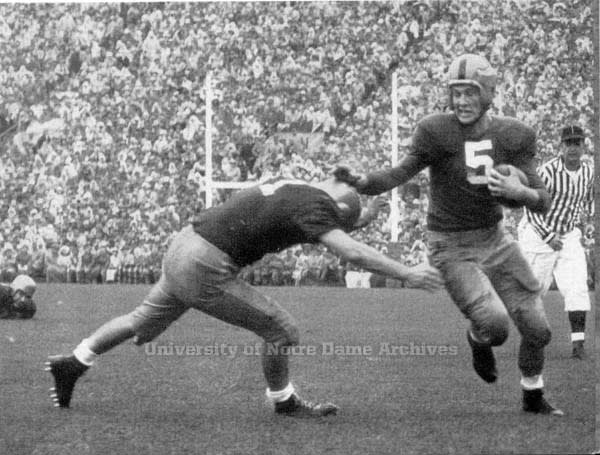Notre Dame's Ol' Kentucky Home

The verbal commitment this weekend from 2019 four-star Bowling Green, Ky., defensive tackle Jacob Lacey was another reflection of Notre Dame’s “national base” when it comes to football recruiting.
Of the 15 verbal pledges so far in the 2018 recruiting class, 12 are from different states. Meanwhile, the two early commits for 2019 — Lacey and Nevada quarterback Cade McNamara — are from two other states. That means of the last 17 to select Notre Dame, 14 hail from a different state.
If or when he signs with the Fighting Irish in 2019, Lacey would become the first native of the Bluegrass State to ink with them since current fifth-year senior offensive lineman Hunter Bivin (Owensboro) in 2013, unless someone else would pop up between now and next February.
Since the turn of the century, Notre Dame has signed only four scholarship players from Kentucky: defensive back Jake Carney (2002-05, Lexington), defensive lineman Brandon Newman (2008-11, Louisville), safety Austin Collinsworth (2010-present, Fort Thomas) and Bivin. By our count, Kentucky has produced 31 players who have seen action at Notre Dame.
Although it is a bordering state, Kentucky has come nowhere close to Ohio, Illinois, Michigan and Indiana at producing the quantity and quality of football talent for the Fighting Irish those states have. It is and always will be a “basketball state,” and it seldom will be considered a viable contender for the SEC title in football. The Wildcats and Vanderbilt generally have been classified among the bottom feeders in the league, although under fifth-year head coach Mark Stoops Kentucky has improved from 2-10 to 5-7, 5-7 and then 7-6 last year.
Despite being a neighboring state, Kentucky also has never played Notre Dame in football, joining Arkansas (recently scheduled for meetings in 2020 and 2025), Auburn and Mississippi State as the lone SEC schools among the 14 in the league not to do so.
That’s not to say a coveted prospect such as Lacey won’t be available on a yearly basis and evaluated by the Notre Dame staff. But while states such as the Carolinas, Georgia or Virginia are trending up more recently on the Irish recruiting radar, Kentucky has remained relatively dormant.
Here are the top 5 (plus one) products the state has produced for Notre Dame:
1. Paul Hornung (Louisville, 1954-56)
They don’t come much better than the 1956 Heisman Trophy winner (despite a 2-8 record) who was the No. 1 overall selection in the NFL Draft. He also is one of only six Notre Dame players to be inducted into both the College and Pro Football Halls of Fame, joining Wayne Millner, George Connor, Alan Page, Dave Casper and Tim Brown. The Golden Boy played fullback in 1954 for the 9-1 Irish before moving to quarterback his last two seasons, but he also was a stalwart on defense and as a kicker and punter.
2. Jack Elder (Louisville, 1927-29)
One of the world’s top sprinters in his day, the left halfback’s signature play came on defense when he intercepted an Army pass in the 1929 season finale and returned it 100 yards for a score in Notre Dame’s 7-0 victory in Yankee Stadium that clinched the national title. It is one of the most significant/timeless plays in Nore Dame history.
3. Leonard “Pete” Bahan (Somerset, 1917-19)
The three-year starter captained Knute Rockne’s first two teams in 1918-19 while getting overshadowed by the immortal George Gipp. The rare distinction as a two-time captain saw him start at right halfback in 1917-18 before moving to quarterback for Rockne’s first unbeaten team (9-0) in 1919.
4. Bob Lehmann (Louisville, 1961-63)
Joined Bahan and Collinsworth as the only other Irish captains from Kentucky when he held that title for interim coach Hugh Devore’s 2-7 team in 1963. The guard/linebacker recorded 197 career tackles, finishing second in that category in both 1962 (61) and 1963 (95).
5. Tony Driver (Louisville, 1997-2000) and Chris Brown (Owensboro, 1980-83)
The defensive back recruits both became sixth-round selections who played two seasons apiece in the NFL. Driver arrived as a USA Today first-team All-American running back recruit but shifted to safety as a sophomore and helped Notre Dame to 9-3 finishes in 1998 and 2000, recording 125 tackles, four interceptions and 12 passes broken up in those two campaigns.
Brown played as a nickel, cornerback and safety, accumulating 83 tackles, 14 passes broken up and four interceptions his last two seasons.
An honorable mention to guard Bernie Crimmins (Louisville, 1939-41), tight end Frank Jacobs (Highland Heights, 1987-89) and running back Ed Ziegler (Woodlawn, 1967-69).
Crimmins was a backup running back his first two years before earning second-team United Press All-American honors for the 8-0-1 team in 1941, head coach Frank Leahy’s first with the Irish.
Jacobs was the nation’s top tight end recruit in 1987 and caught a TD pass in the 1989 Fiesta Bowl national title win over West Virginia, but he pursued a baseball career after his junior season.
Ziegler was the second-leading rusher for the 1969 Irish with 483 yards and also caught two touchdown passes.
----
• Talk about it inside Rockne's Roundtable
• Subscribe to our podcast on iTunes
• Learn more about our print and digital publication, Blue & Gold Illustrated.
• Follow us on Twitter: @BGINews, @BGI_LouSomogyi, @BGI_CoachD,
@BGI_MattJones, @BGI_DMcKinney and @BGI_CoreyBodden.
• Like us on Facebook
